
Creating a bonsai garden is an enchanting experience and dream of every bonsai owner who owns more than one bonsai. Having this garden in your home is like blending art and nature in the form of a miniature forest. Every single tree is an example of your utmost care and attention, and when presented properly each one of them will stand out to the viewers.
I am quite sure that you thought gathering all your bonsai plants and keeping them in an empty space would create a bonsai garden. But sorry to inform you, it’s not as easy as it looks in the pictures. Every tree has its own personality, some like warm weather, and some like cold, so it’s clear placing them together will not be a healthy option for them. On the other hand, you need to display your trees in a way they won’t look stacked up.
Handling countless bonsai trees over the years helped me to understand each of their characteristics, Which trees can live side by side without making any fuss? what design you can employ in your space? and what are those trees you can use?
I’m confident that the whole guideline will help you to get started, so let’s begin!
What is a bonsai garden?
In short, a bonsai garden is the exhibition of your bonsai artwork collection. Japanese horticulturists started showcasing their bonsai art in a way that look like a striking example of a miniature forest. Instead of stacking all of their artwork in a place they used benches, poles, and other methods in a way that every single tree can stand out as an example of “nature’s beauty meets human creativity”.
For example, in the following image, the garden is beautifully curated with benches and poles;
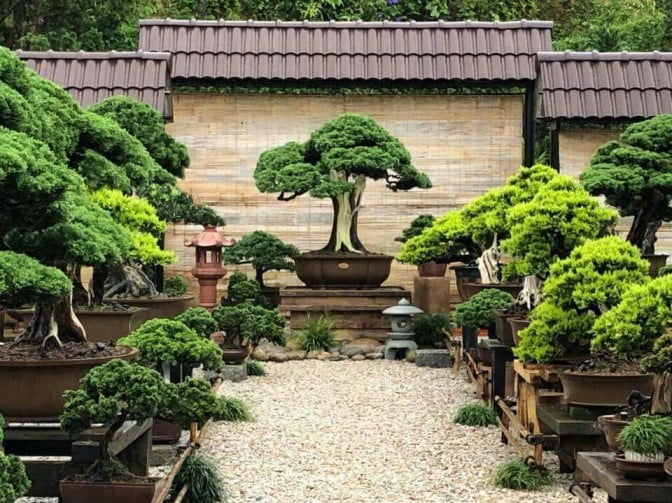
Now, let’s dive into the details.
Things you need to consider before creating a well-designed bonsai garden:
To build a successful and long-lasting garden, multiple factors need to be taken into consideration. For example, understanding the space, and deciding the spot is the key. The structure should involve considerable decks or levels and tracks for visual appeal and easy navigation. Right plants and trees that go well together in terms of size and shade are essential for a compatible look.
Suitable bonsai plant selection:
Plant selection is the most important factor for this garden creation. The plants you will select should blend well in terms of color, texture, size, and seasons. For example, some trees lose leaves in winter, some change color in fall, and some stay green all over the year, so if you incorporate accordingly you can keep your garden alive and beautiful all over the year. The group of trees should also be in favor of your residing region.
Here’s my personal selection of trees you can use for your garden as well;
| Sun-loving bonsai | Shade-loving bonsai | Cold hardy bonsai | Bonsai for hot regions | Indoor bonsai | Outdoor bonsai |
| Juniper | Azalea | Chinese elm | Ficus | Ficus | Juniper |
| Pine | Ficus | Pine | Chinese elm | Carmona | Elm |
| Cedar | Jade | Japanese maple | Carmona | Chinese elm | Azalea |
| Japanese maple | Carmona | Azalea | Jade | Jade | Boxwood |
| Jade | Pachira | Juniper | Maple | Money tree | Maple |
Considering the space:
I have seen people not taking space as a primary factor to consider, but believe me it is as important as choosing the right species for your garden. You need to calculate the number of trees, their potential growth, and spacing beforehand.
One or two extra trees in your garden are still fine, but when they multiply in number not only the look will get hampered but also it will affect the air circulation.
Considering the climate of your region:
Before getting a bonsai, researching their native region is important. It goes without saying, your bonsai will thrive if you can imitate their native environment. In the tree selection section, I have grouped some of the trees for different environments, you will also notice some trees got placed in both cold hardy, and hot climates trees, meaning they are one of the hardiest bonsai species which can survive hot and cold at the same rate.
If you are a beginner I will advise you to Choose one of those hardy plants, then increase your collection according to the region you are living in, before constructing a whole garden.
Note:
If you are from a tropical region, go for ficus trees as a beginner.
Finding the ideal spot for your bonsai garden:
An excellent garden forms by finding a location that fulfills the conditions of bonsai trees. This includes equipping with adequate sunlight and shelter from storms and frost.
Creating the layout:
Draw a layout of the outlook you want to see as a finished result. Don’t worry you don’t have to be a pro painter to do it, just a doodle that you can understand. Believe me, it does sound like an ignorable step, but it will help you a great deal to keep you on track.
Adding decorative accents:
Decorative accents like water and lighting features will enhance your garden. You can add a small fountain or pond in your garden as well, this will not only elevate the look of the garden with elegance but also will provide humidity.
These elements might be expensive but they are optional as well. Even though they are optional I still included them in the consideration section, as if you want a certain look you can be aware of the money you will be spending (I am sure you are aware but let me remind you that fountains will dent your pocket).
Implementing protection from the extreme environment:
Even if you and your tree’s region match, you still need to keep in mind that protection is needed for adverse times. If your bonsai garden is in the outdoors, investing in a shade cloth is a smart choice. It will shield the scorching sun in mid-summer but also will give enough light for photosynthesis.
Types of bonsai gardens?
The garden structure can be created as far as your imagination goes, but here are the common types of bonsai garden ideas so you will have a clear view of which one you will incorporate for your garden.
Vertical pole bonsai garden:
Japanese bonsai gardeners mostly use this design, they display their trees in the center of a vertical pole. This way all trees are placed at eye level and stand out to the visitors.
The poles can be available in numerous materials like wood, old trunks, stone slabs, and concrete pillars. Here are some reference images below;
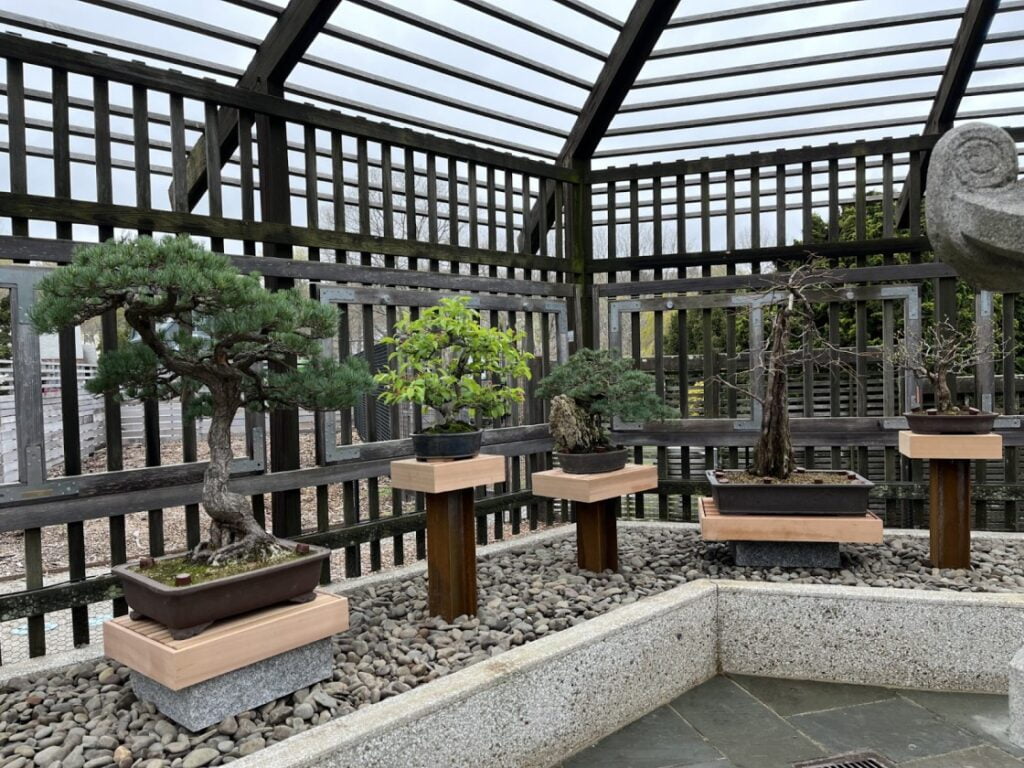
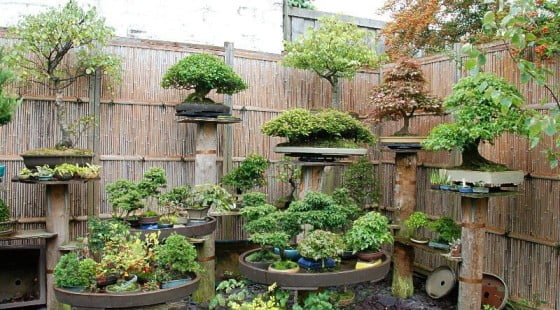
Bench bonsai garden:
Constructing a bench can be tricky as you have to be mindful of durability and functionality.
Thinks you need to consider while constructing a bench;
- Width, depth, and height.
- Strong leg and support system.
- Drainage system.
- Spacing between each bonsai tree.
Here are two kinds of bonsai bench examples;

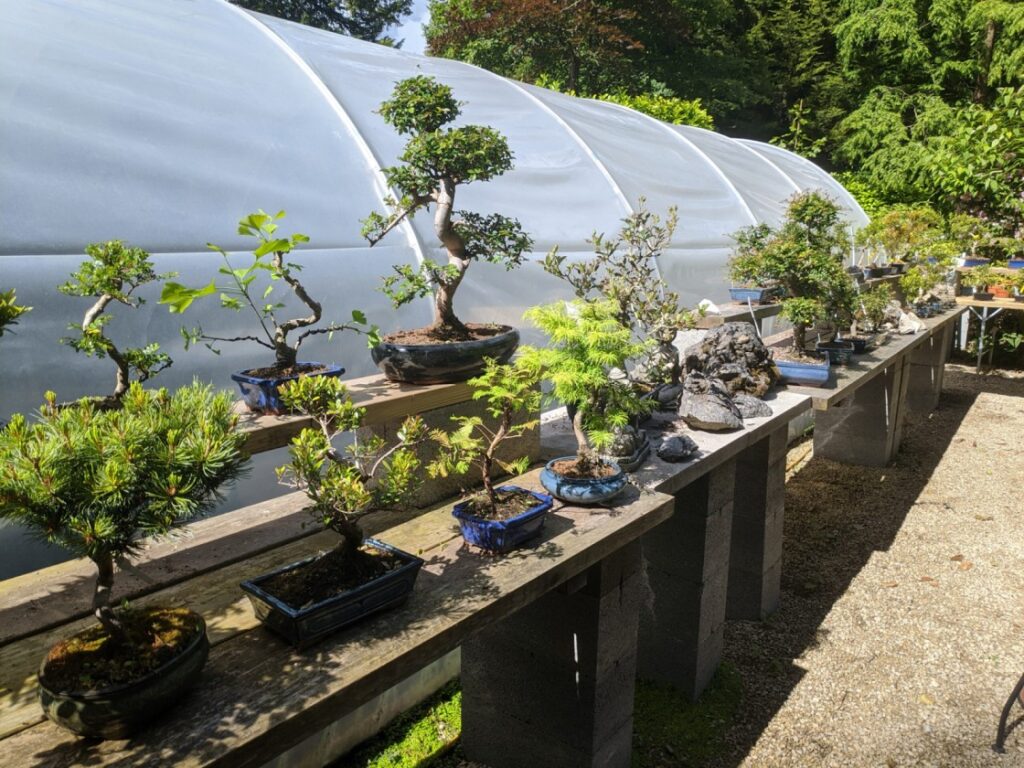
Verticle bonsai garden:
You can also call it selves bonsai garden design. It’s a great way to showcase your bonsai collection but you will need a high-length wall to create this design. This design is frequently used in indoor gardens. Here are some pictures though which you can easily understand the design.
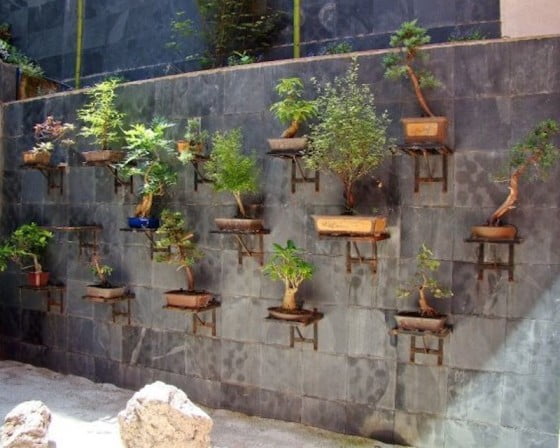
Outdoor garden

Indoor garden
Bonsai dish garden:
Dish gardens are a sort of garden in one container where multiple plants are cultivated in small, open dishes or containers. A bonsai dish garden may include plants of the same or distinct species. These dish gardens are generally utilized to add color or texture to a room, whether indoors.
These gardens are most common as indoor gardens.
Some of the most used bonsai species for dish gardening are juniper, ficus, Japanese maple, etc.
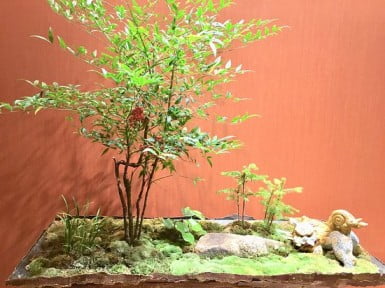

Bonsai terrarium garden:
Terrariums are glass pots in which bonsai plants can be kept. Not all trees are suitable to create a terrarium garden. Only trees that thrive in high humidity can survive in a glass jar. This design is also mostly used for indoor spaces.
For Terrariums, the Most suitable Bonsai trees are:
Ficus
Ficus ginseng
Ficus retusa
Carmona/Fukien Tea
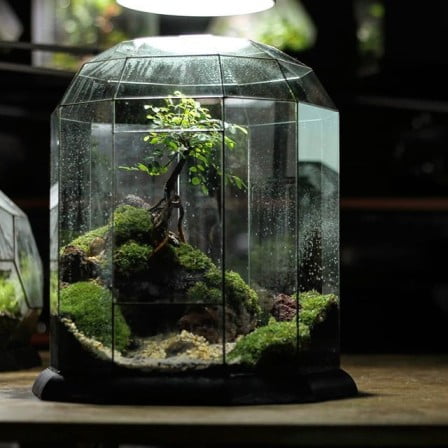
What are the best bonsai garden ideas?
Now that we know the types of designs you can utilize with your bonsai collection to create a garden, here are some of my favorite bonsai garden ideas that you can employ as well.
Indoor bonsai garden ideas:
For indoor gardens two most suitable ways to add a touch of greenery are, constructing it near your window and showcasing it on an empty wall.
Windowsill bonsai garden:
If you own indoor plants I am sure you are well aware of the fact that most (if not all) plants should stay near sunlit windows. So why not create your bonsai garden right at that spot?
Your bonsai will be basking in sunlight while flaunting its beauty.
Note:
You can play with the arrangements near your window, but if you have a compact space you can create a bonsai dish garden and place it near your window.
Tips:
I have seen the downside of this garden design is the drainage system. So to avoid this issue make sure you are using containers that drain thoroughly and also ensure to open your window from time to time for air circulation.


Bonsai shelves:
I will highly recommend you utilize this design if you have an empty bland wall. If you create a vertical selves garden in your in our living room, trust me you won’t need another furniture in your room to make it elegant.
Tip:
- As they won’t have any natural environmental source, pick the hardiest shade-loving plants for the design.
- To elevate the look even more, you can use terrarium bonsais in the selves.
- Individual lights near every tree will give the spotlight and fulfill the light requirement.
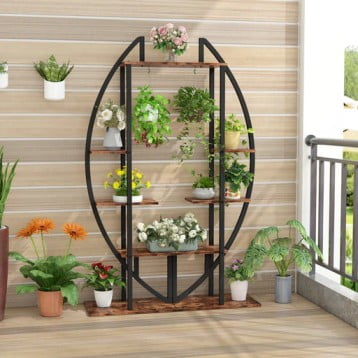
The plants showcased here are not bonsai but are only used for reference
Outdoor bonsai garden ideas:
Balcony garden:
This is for people who own a collection of outdoor bonsai but live in a compact apartment and the only outdoor space available for them is the balcony.
For the balcony bonsai garden, you can utilize a small bench design or a vertical display design.
Observe the atmosphere of your balcony for sunlight reach, wind, and rain protection, and choose your species accordingly.

Backyard bonsai garden:
Having a spacious garden is like winning a lottery for bonsai gardeners. You can incorporate any kind of design in your backyard and transform it into bonsai heaven. You can also utilize more than one design in your garden.
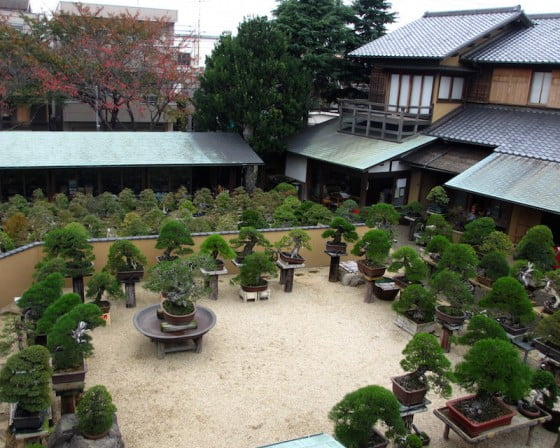
How to incorporate your bonsai into landscape design step by step:
The tree you will pick for design should match your overall aesthetic of the space, be it indoor or outdoor. Keep in mind a bonsai garden will be successful only when they are properly fed, watered, shaped, and re-potted.
Materials you will need:
Bonsai tree:
Choose the tree that is suitable for your climate and space. Suppose you live in a hot climate, you can use ficus, Chinese elm, and Carmona plants. Same characteristics plants will be easier to tend and be in their healthiest form.
Tip:
Keep the healthiest one in the center.
Bonsai pot:
Your bonsai pot should coordinate with the plant. For bonsai, there are countless pots available, with distinctive builds, depths, widths, and shades.
I will advise you to use jade pots if you’re opting for a Japanese theme. This special kind of pot is known as the Japanese bonsai pot.
Bonsai potting soil:
You can get it in your local nursery or online.
Aggregates:
To boost the drainage system.
Rocks:
Rocks are used to enhance the look of the design. Clear boulders with defines shapes of rocks can be bought from local stores or collected from your neighborhood.
Weed control mat (optional):
After completing the gardening work you might notice wild weeds are growing from the ground after a few days, hampering the look and ruining all hard work. Covering the ground with stone won’t help, you will need a weed mat to control their growth. But if you are vigilant enough and willing to clear every time a weed starts to peek, you won’t need it.
Other tools:
Tools like shovels, water cans, pruners, pliers, and of course the structures according to your chosen design are also required.
Deciding on the suitable design:
The design you will incorporate must be carefully planned. Combining other materials with the bonsai should be the goal of the design. Other materials mean- Water, soil, rock, grass, etc.
Here are a few strategies you can follow while deciding on your bonsai garden ideas;
- Determine the amount of area you will be using.
- Note down the immovable objects in your space and determine which garden design (pole, bench, or shelves) will go with it.
- After you are done with deciding, observe the spot’s light and air reach. It will help you to select the plants for your bonsai.
Using rocks for landscaping:
You can add any elements you like, but rock is most commonly employed in the design so I added it as a section. Most gardeners use rocks in various sizes and shapes, to create some sort of dramatic effect (they are also cheap).
Big and small pebbles are often used in bonsai gardens. Individually every bonsai tree is generally encircled by small rocks, while bigger rocks are employed as additional garden focal points.
Large rocks generally stay upright rather than horizontally.
Pick rocks with vertical cracks because even in other rock shapes, these have the potential to let bonsai roots extend onto the rock.
Preparing the structure:
Verticle pole:
The poles can be made of varied materials- stone, concrete, wood, and old wood logs. If you live in a windy area go for concrete or stone poles. If you want your garden to last for years, ensure the poles are securely anchored in the ground.
Bench:
Benches also can be constructed with various materials- wood, metal, and concrete. While constructing your benches make sure there are some holes or gaps in between every pot so you can anchor the pots with the bench to protect it from wind.
Shelves:
Shelves are usually secured with screws in the wall. Make sure they are sturdy enough. Since the bonsais will be staying near the wall you don’t have to worry about the wind.
Dish (for bonsai dish garden):
Make sure the dish or tray has drainage holes.
Terrarium garden:
The glass bowl should have an open end.
Preparing the trees:
Choose the best trees from your collection, they should be placed in the middle of your garden, while others will stay by their side and prepare to be in their healthiest form through your attention.
Before arranging them in your garden;
- Prune them, and make sure to remove every unattractive, damaged part.
- The shape of the bonsai should fo well with the pruning.
- Re-pot them in attractive pots that will match well with all the other plants.
Arranging the tree:
After all structures and trees are prepared, it’s time to arrange the trees. While arranging you need to ensure;
- Not placing big and small trees next to each other.
- Make sure every pot is safe from the wind.
- Outdoor pots should be anchored with the structure.
- The shade-cloth structure frame should be installed to combat hot summer days and winter breezes.
Adding additional elements:
You can add extra elements to your bonsai garden to bring out the finest in the surrounding trees and pebbles. Water elements like tiny cascades, fountains, or ponds with live fish are choices you might use. Other additions like lighting, lights, and roofs can be used (the sky is the limit).
Use accent plants:
Accent plants are another way to enhance the look of the bonsai. Rocks and other decorative elements are also accents, but in this case, live plants are used as an accent.
The intention of including an accent plant is to show a contrast to the tree and add proportion and optical appeal to the overall exhibition.
Most of the time accent plants are not bonsai, they are just small plants accompanying your bonsai.
Small succulents, hostas, ferns, and diminutive irises make great accent plants.
What are the best bonsai garden plants?
Juniper:
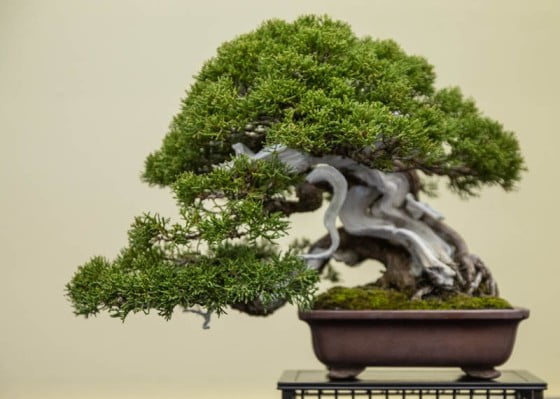
Pine:
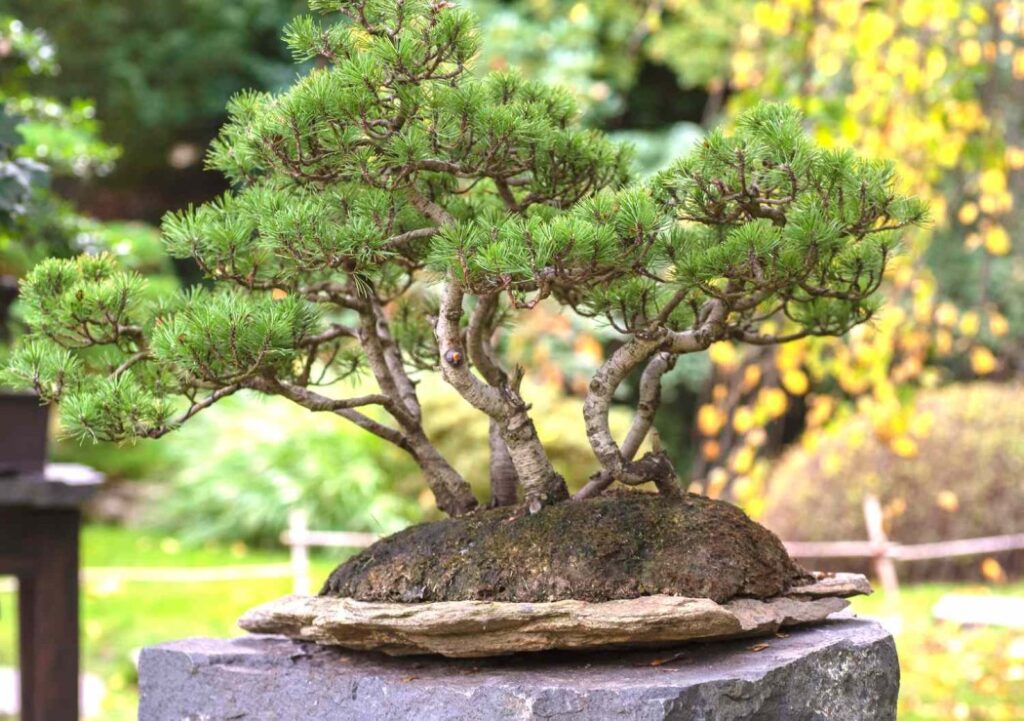
Japanese Maple:
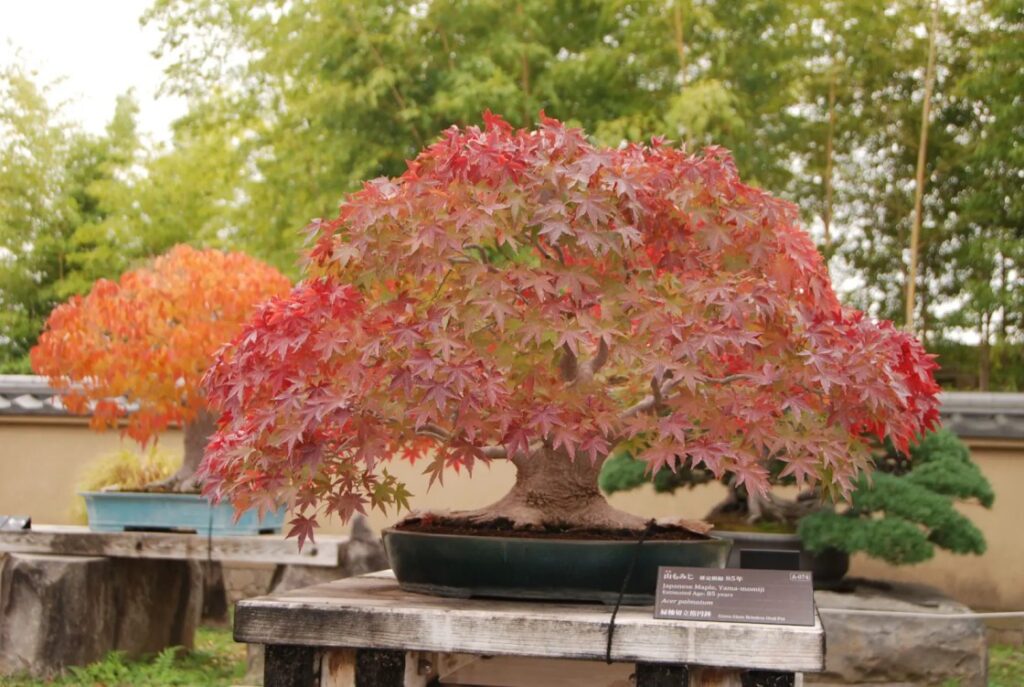
Ficus:

Jade Bonsai:
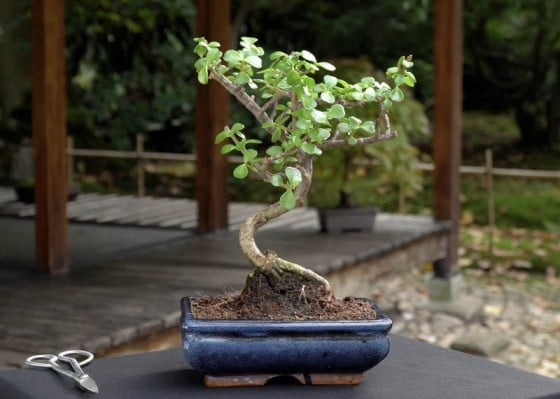
Boxwood Bonsai:

Azalea:
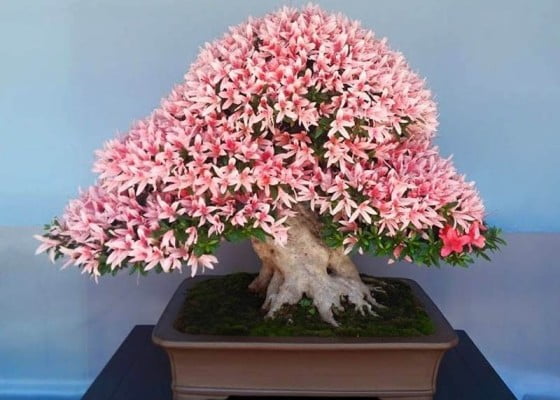
Chinese Elm:
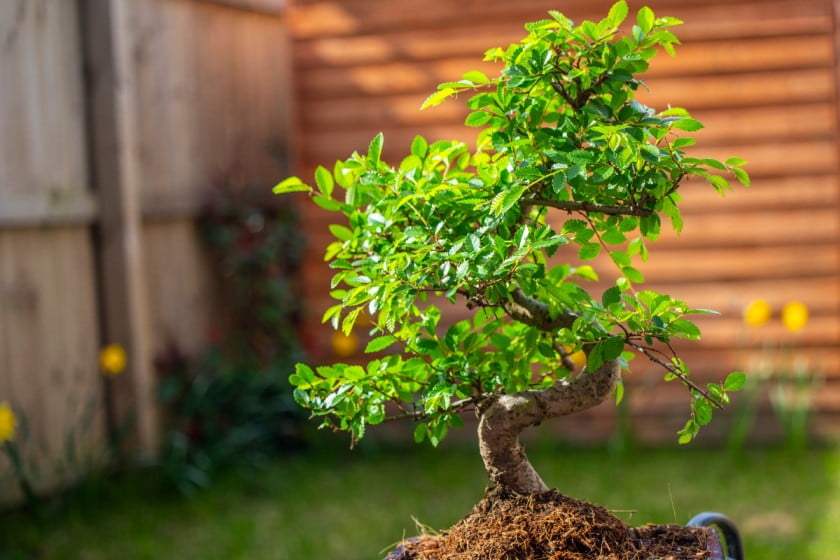
Key Takeaways:
- Designing a well-structured garden with bonsai is hard but the key factor is to keep them at eye level.
- Be it rain, extreme sunlight, or wind, using shade cloth over your design will protect the trees and structure as well.
- Keep your best trees in the middle and others by the side,
- Wood, stone, and concrete all can be used to create the structure.
- The suitable species for a Bonsai garden are pine, juniper, elm, and jade trees.
